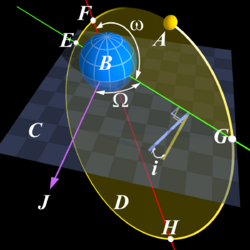Apsis
- "Apogee" redirects here.
In celestial mechanics, an apsis, plural apsides (pronounced /ˈæpsɨdɪːz/) is the point of greatest or least distance of the elliptical orbit of an object from its center of attraction, which is generally the center of mass of the system.
The point of closest approach is called the periapsis or pericentre and the point of farthest excursion is called the apoapsis (Greek από, from, which becomes απ before a vowel, and αφ before rough breathing), apocentre or apapsis (the latter term, although etymologically more correct, is much less used). A straight line drawn through the periapsis and apoapsis is the line of apsides. This is the major axis of the ellipse, the line through the longest part of the ellipse.
Derivative terms are used to identify the body being orbited. The most common are perigee and apogee, referring to orbits around the Earth (Greek γη gê earth), and perihelion and aphelion, referring to orbits around the Sun (Greek ‘ήλιος hēlios sun). During the Apollo program, the terms pericynthion and apocynthion were used when referring to the moon.
Formula

These formulae characterize the periapsis and apoapsis of an orbit:
- Periapsis: maximum speed at minimum (periapsis) distance
- Apoapsis: minimum speed at maximum (apoapsis) distance
while, in accordance with Kepler's laws of planetary motion (conservation of angular momentum) and the conservation of energy, these quantities are constant for a given orbit:
- specific relative angular momentum
- specific orbital energy
where:
- is the semi-major axis
- is the standard gravitational parameter
- is the eccentricity, defined as
Note that for conversion from heights above the surface to distances between an orbit and its primary, the radius of the central body has to be added, and conversely.
The arithmetic mean of the two limiting distances is the length of the semi-major axis . The geometric mean of the two distances is the length of the semi-minor axis .
The geometric mean of the two limiting speeds is , the speed corresponding to a kinetic energy which, at any position of the orbit, added to the existing kinetic energy, would allow the orbiting body to escape (the square root of the product of the two speeds is the local escape velocity). Aphelion also refers to a comet that is far from the Sun. A perihelion is also a comet that is close to the Sun.
Terminology
The words "pericentre" and "apocentre" are occasionally seen, although periapsis/apoapsis are preferred in technical usage.
Various related terms are used for other celestial objects. The '-gee', '-helion' and '-astron' and '-galacticon' forms are frequently used in the astronomical literature, while the other listed forms are occasionally used, although '-saturnium' has very rarely been used in the last 50 years. The '-gee' form is commonly (although incorrectly) used as a generic 'closest approach to planet' term instead of specifically applying to the Earth. The term peri/apomelasma (from the Greek root) was used by physicist Geoffrey A. Landis in 1998 before peri/aponigricon (from the Latin) appeared in the scientific literature in 2002 [citation needed].
| Body | Closest approach | Farthest approach |
|---|---|---|
| Galaxy | Perigalacticon | Apogalacticon |
| Star | Periastron | Apastron |
| Black hole | Perimelasma/Peribothra/Perinigricon | Apomelasma/Apobothra/Aponigricon |
| Sun | Perihelion | Aphelion[1] |
| Mercury | Perihermion | Apohermion |
| Venus | Pericytherion/Pericytherean/Perikrition | Apocytherion/Apocytherean/Apokrition |
| Earth | Perigee | Apogee |
| Moon | Periselene/Pericynthion/Perilune | Aposelene/Apocynthion/Apolune |
| Mars | Periareion | Apoareion |
| Jupiter | Perizene/Perijove | Apozene/Apojove |
| Saturn | Perikrone/Perisaturnium | Apokrone/Aposaturnium |
| Uranus | Periuranion | Apouranion |
| Neptune | Periposeidion | Apoposeidion |
| Pluto | Perihadion | Apohadion |
Since "peri" and "apo" are Greek, it is considered by some purists[2] more correct to use the Greek form for the body, giving forms such as '-zene' for Jupiter and '-krone' for Saturn. The daunting prospect of having to maintain a different word for every orbitable body in the solar system (and beyond) is the main reason why the generic '-apsis' has become the almost universal norm.
- In the Moon's case, in practice all three forms are used, albeit very infrequently. The '-cynthion' form is, according to some, reserved for artificial bodies, whilst others reserve '-lune' for an object launched from the Moon and '-cynthion' for an object launched from elsewhere. The '-cynthion' form was the version used in the Apollo Project, following a NASA decision in 1964.
- For Venus, the form '-cytherion' is derived from the commonly used adjective 'cytherean'; the alternate form '-krition' (from Kritias, an older name for Aphrodite) has also been suggested.
- For Jupiter, the '-jove' form is occasionally used by astronomers whilst the '-zene' form is never used, like the other pure Greek forms ('-areion' (Mars), '-hermion' (Mercury), '-krone' (Saturn), '-uranion' (Uranus), '-poseidion' (Neptune) and '-hadion' (Pluto)).
Earth's perihelion and aphelion
The Earth is closest to the Sun in early January and farthest in early July. The relation between perihelion, aphelion and the Earth's seasons changes over a 21,000 year cycle. This anomalistic precession contributes to periodic climate change (see Milankovitch cycles).
The day and hour of these events for the next few years are:[3]
| Year | Perihelion | Aphelion |
|---|---|---|
| 2007 | January 3 20Z | July 7 00Z |
| 2008 | January 3 00Z | July 4 08Z |
| 2009 | January 4 15Z | July 4 02Z |
| 2010 | January 3 00Z | July 6 11Z |
| 2011 | January 3 19Z | July 4 15Z |
| 2012 | January 5 00Z | July 5 03Z |
| 2013 | January 2 05Z | July 5 15Z |
| 2014 | January 4 12Z | July 4 00Z |
| 2015 | January 4 07Z | July 6 19Z |
| 2016 | January 2 23Z | July 4 16Z |
See also
Notes
- ↑ Properly pronounced 'affelion' because the (neo) Greek is αφήλιον, although the hypercorrection 'ap-helion' is commonly heard.
- ↑ Apsis. Glossary of Terms. National Solar Observatory (2005-02-21). Retrieved 2006-09-30.
- ↑ Earth's Seasons Equinoxes, Solstices, Perihelion, and Aphelion - 2000-2020 — U.S. Naval Observatory, Astronomical Applications Department; 2003-10-30 (accessed 2007-05-06).
ReferencesISBN links support NWE through referral fees
- Open University. 1990. Planetary Orbits. Mathematical Models and Methods, Unit 30. Milton Keynes, UK: Open University. ISBN 0749220368
- Rees, Martin J., ed. 2008. Universe. New York, N.Y.: DK. ISBN 978-0756636708
- Seeds, Michael A. 2008. The Solar System, 6th ed. Belmont, CA: Thomson Brooks/Cole. ISBN 978-0495387879
External links
- Apogee - Perigee Photographic Size Comparison
- Aphelion - Perihelion Photographic Size Comparison
- Aphelion - Perihelion Dates and Times
| ||||||||||||||||||||||||||||||||||||||||||||||
Credits
New World Encyclopedia writers and editors rewrote and completed the Wikipedia article in accordance with New World Encyclopedia standards. This article abides by terms of the Creative Commons CC-by-sa 3.0 License (CC-by-sa), which may be used and disseminated with proper attribution. Credit is due under the terms of this license that can reference both the New World Encyclopedia contributors and the selfless volunteer contributors of the Wikimedia Foundation. To cite this article click here for a list of acceptable citing formats.The history of earlier contributions by wikipedians is accessible to researchers here:
The history of this article since it was imported to New World Encyclopedia:
Note: Some restrictions may apply to use of individual images which are separately licensed.

























